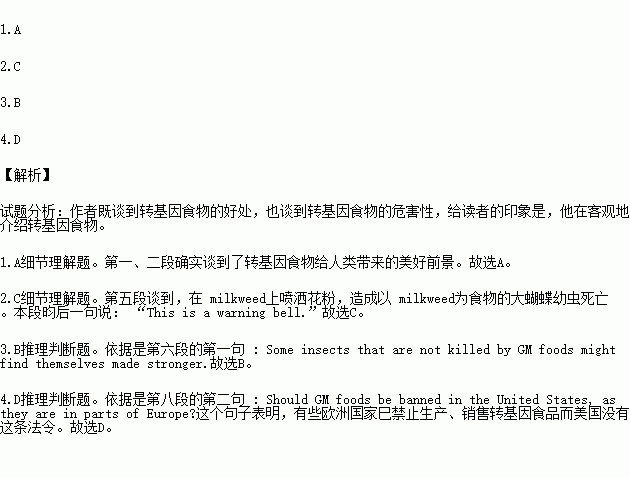题目内容
Experiments under way in several labs aim to create beneficial types of genetically modified foods, including starchier potatoes and caffeine-free coffee beans. Genetic engineers are even trying to transfer genes from a cold-winter fish to make a frost-resistant tomato.
A low-sugar GM strawberry now in the works might one day allow people with health problems such as diabetes (糖尿病) to enjoy the little delicious red fruits again. GM beans and grains rich in protein(蛋白质) might help people at risk of developing kwashiorkor. Kwashiorkor, a disease caused by severe lack of protein, is common in parts of the world where there are severe food shortages.
Commenting on GM foods, Jonathon Jones, a British researcher, said: "The future benefits will be enormous(巨大的), and the best is yet to come". To some people, GM foods are no different from unmodified foods. "A tomato is a tomato," said Brian Sansoni, an American food manufacturer.
Critics of GM foods challenge Sansoni's opinion. They worry about the harm that GM crops might do to people, other animals, and plants.
In a recent lab study conducted at Cornell University, scientists tested pollen(花粉) made by BT corn, which makes up one-fourth of the U.S. corn crop. The scientist dropped the pollen onto milkweed, a plant that is the only known food source of a butterfly caterpillar(毛虫). Within four days of feeding on the leaves, almost half of a test group of caterpillars died. "This is a warning bell." said Cornell researcher Linda Raynor.
Some insects that are not killed by GM foods might find themselves made stronger. How so? The insecticides are used on the crops to kill the pests. But GM plants produce a continuous level of insecticide. Insects relying on those crops may develop resistance to the plants and they may also develop a resistance to the insecticide.
At the forum on GM food held last year in Canada. GM crops that have been made resistant to the herbicide might crossbreed with wild plants, creating "superweeds" that could take over whole fields.
So where do you stand? Should GM food be banned in the United States, as they are in parts of Europe? Or do their benefits outweigh(胜过) any of the risks they might carry?
1. The first three paragraphs try to give the idea that__________
A. GM foods may bring about great benefits to humans.
B. GM foods are no different from ordinary ones.
C. GM foods may have both benefits and harm.
D. GM foods are particularly good to the kwashiorkor patients.
2. Why is the pollen-sprayed milkweed mentioned in Paragraph 5?
A. To show GM foods can kill insects effectively.
B. To show GM foods contain more protein.
C. To show GM foods also have a dark side.
D. To show GM foods may harm crops.
3. What happens to those insects when not killed by the spray of insecticide?
A. They may lose their ability to produce lay eggs.
B. They may have a higher ability to adapt to the environment.
C. They move to other fields free from insecticide.
D. They never eat again those plants containing insecticide.
4. Which of the following statements concerning banning GM foods is true according to the passage?
A. Underdeveloped countries have banned GM foods.
B. Both Europe and the U.S. have banned GM foods.
C. Most European countries have not banned GM foods.
D. The United States has not banned GM foods.

